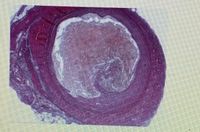
Human Anatomy & Physiology (11th Edition)
11th Edition
ISBN: 9780134580999
Author: Elaine N. Marieb, Katja N. Hoehn
Publisher: PEARSON
expand_more
expand_more
format_list_bulleted
Question
Plsssssss helpppppp. Is this a normal or abnormal coronary artery, why or why not?

Expert Solution
arrow_forward
Step 1
Coronary artery is supplyes blood to heart muscle. If it damages then heart muscle does not works properly then it called coronary artery disease.
Step by stepSolved in 2 steps with 1 images

Knowledge Booster
Similar questions
- Identify layers or tunics of an artery and veinarrow_forwardConceptualize in Color Principal Veins Identify and color the principal veins in the figure using the colors suggested, or choose your own. • Basilic: Purple • Cephalic: Orange • Axillary: Pink • Subclavian: Blue • Brachiocephalic: Green • Superior vena cava: Dark red • Internal jugular: Orange • External jugular: Purple • Median cubital: Green • Inferior vena cava: Tan • External iliac: Red • Internal iliac: Dark blue • Common iliac: Yellow • Hepatic: Light red • Great saphenous: Brown • Posterior tibial: Orange • Anterior tibial: Gold • Popliteal: Pink • Femoral: Purple Chapter 16 Vascular System 207arrow_forwardName the structure separating these two chambers of the heart. O anterior interventricular sulcus O chordae tendinae O interventricular septum O interatrial septum « Previousarrow_forward
- Why do interstitial fluids build up in the capillary beds of tissues? O the venous capillaries absorb more fluids than can be delivered by arterial capillaries O more fluid is usually released by arterial capillaries than is absorbed by venous capillaries O interstitial spaces lack dissolved proteins or other types of dissolved electrolytes O tissue cells within the capillary beds tend to expel fluids into nearby open spaces Nextarrow_forwardAfter passing through the subclavian vein blood next passes into the ______. A axillary vein and then into the brachial vein B right atrium and then into the right ventricle C subclavian artery and then into the capillary beds in the armpit region D brachiocephalic vein and then into the superior vena cava E internal jugular vein and then into the external jugular veinarrow_forwarddiscribe Decrease with cardiac output, arteries stiffeningarrow_forward
- https://www.youtube.com/watch?v=t0IngUYN2OA https://www.youtube.com/watch?v=pPxnIh_WTb8 Part1 1) How would the BP of an anxious patient visiting a doctor be different than if the patient is calm? 2) In atherosclerosis, plaque builds up inside the arteries. How would this affect BP? Is this an example of hypertension or hypotension? Part 2: The circulatory system has 5 functions. · Highlight the statements below that are only functions of the circulatory system. It carries cells that help to fight diseases. It gives structure and support to the body. It carries waste products to the urinary system. It carries carbon dioxide from cells to the lungs. It maintains body posture. It carries nutrients from the digestive system to other cells. It carries oxygen from the lungs to other cells. · The list gives some structures in the blood and circulatory system. Heart, artery, red blood cell, ventricle, capillary, plasma, vein, white blood…arrow_forwardActivation of the vascular endothelium is an important event associated with cardiovascular diseases. Explain why. (minimum 60 words)arrow_forwardplease help me, I am using this to study but I do not know if my answer is correct.arrow_forward
- Clinical Corner: In speaking with his cardiologist, a high risk individual with angina pectoris during exercise was informed that his coronary blood flow is reduced. The most important variable that determines resistance to blood flow in his blood vessels is most likely: increased viscosity of blood from not exercising. the length of the blood vessel as he is a short individual. the diameter of the vessel due to coronary artery disease. increase blood pressure due to hypertension.arrow_forwardpls explain! please and thank you!arrow_forwardaUL U2 aUF What is the RED circled leads showing? Name the correct SIDE of the heartarrow_forward
arrow_back_ios
SEE MORE QUESTIONS
arrow_forward_ios
Recommended textbooks for you
 Human Anatomy & Physiology (11th Edition)BiologyISBN:9780134580999Author:Elaine N. Marieb, Katja N. HoehnPublisher:PEARSON
Human Anatomy & Physiology (11th Edition)BiologyISBN:9780134580999Author:Elaine N. Marieb, Katja N. HoehnPublisher:PEARSON Biology 2eBiologyISBN:9781947172517Author:Matthew Douglas, Jung Choi, Mary Ann ClarkPublisher:OpenStax
Biology 2eBiologyISBN:9781947172517Author:Matthew Douglas, Jung Choi, Mary Ann ClarkPublisher:OpenStax Anatomy & PhysiologyBiologyISBN:9781259398629Author:McKinley, Michael P., O'loughlin, Valerie Dean, Bidle, Theresa StouterPublisher:Mcgraw Hill Education,
Anatomy & PhysiologyBiologyISBN:9781259398629Author:McKinley, Michael P., O'loughlin, Valerie Dean, Bidle, Theresa StouterPublisher:Mcgraw Hill Education, Molecular Biology of the Cell (Sixth Edition)BiologyISBN:9780815344322Author:Bruce Alberts, Alexander D. Johnson, Julian Lewis, David Morgan, Martin Raff, Keith Roberts, Peter WalterPublisher:W. W. Norton & Company
Molecular Biology of the Cell (Sixth Edition)BiologyISBN:9780815344322Author:Bruce Alberts, Alexander D. Johnson, Julian Lewis, David Morgan, Martin Raff, Keith Roberts, Peter WalterPublisher:W. W. Norton & Company Laboratory Manual For Human Anatomy & PhysiologyBiologyISBN:9781260159363Author:Martin, Terry R., Prentice-craver, CynthiaPublisher:McGraw-Hill Publishing Co.
Laboratory Manual For Human Anatomy & PhysiologyBiologyISBN:9781260159363Author:Martin, Terry R., Prentice-craver, CynthiaPublisher:McGraw-Hill Publishing Co. Inquiry Into Life (16th Edition)BiologyISBN:9781260231700Author:Sylvia S. Mader, Michael WindelspechtPublisher:McGraw Hill Education
Inquiry Into Life (16th Edition)BiologyISBN:9781260231700Author:Sylvia S. Mader, Michael WindelspechtPublisher:McGraw Hill Education

Human Anatomy & Physiology (11th Edition)
Biology
ISBN:9780134580999
Author:Elaine N. Marieb, Katja N. Hoehn
Publisher:PEARSON

Biology 2e
Biology
ISBN:9781947172517
Author:Matthew Douglas, Jung Choi, Mary Ann Clark
Publisher:OpenStax

Anatomy & Physiology
Biology
ISBN:9781259398629
Author:McKinley, Michael P., O'loughlin, Valerie Dean, Bidle, Theresa Stouter
Publisher:Mcgraw Hill Education,

Molecular Biology of the Cell (Sixth Edition)
Biology
ISBN:9780815344322
Author:Bruce Alberts, Alexander D. Johnson, Julian Lewis, David Morgan, Martin Raff, Keith Roberts, Peter Walter
Publisher:W. W. Norton & Company

Laboratory Manual For Human Anatomy & Physiology
Biology
ISBN:9781260159363
Author:Martin, Terry R., Prentice-craver, Cynthia
Publisher:McGraw-Hill Publishing Co.

Inquiry Into Life (16th Edition)
Biology
ISBN:9781260231700
Author:Sylvia S. Mader, Michael Windelspecht
Publisher:McGraw Hill Education